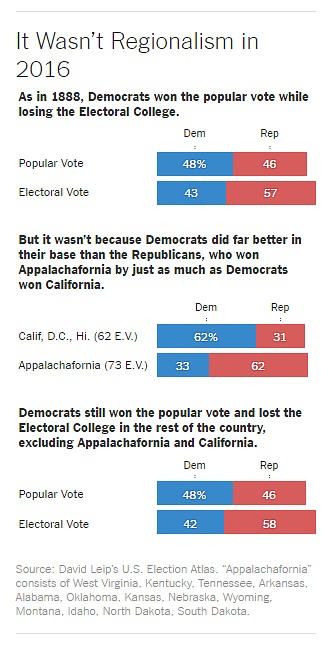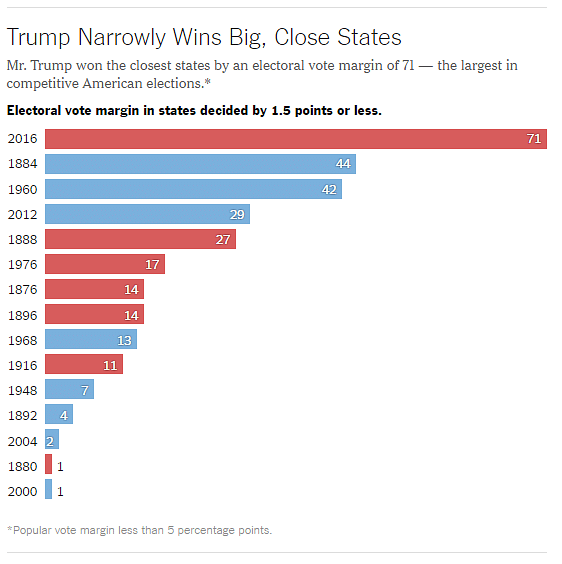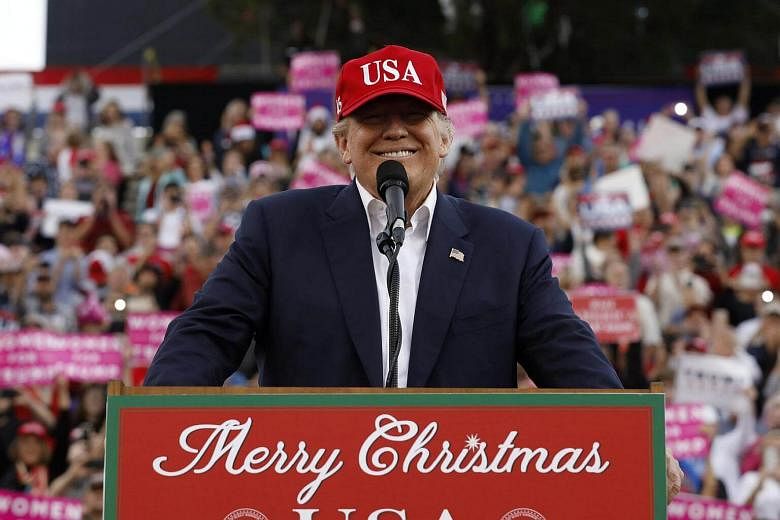NEW YORK (NYTIMES) - With an expected win in the Electoral College today, Donald J. Trump will seal his presidential victory - despite losing the national popular vote by a significant margin.
His Electoral College lead should be substantial, since he won states worth 306 electoral votes to 232 from states won by Hillary Clinton. Yet the nearly final popular vote count has him trailing by nearly three million votes, or 2.1 percentage points, the largest deficit for a winning candidate since 1876's notorious election.
How exactly did we end up with such divergent results?
Liberals say Mr Trump's victory is proof that the Electoral College is biased against big states and undemocratically marginalizes urban and nonwhite voters. Conservatives say the Electoral College serves as a necessary bulwark against big states, preventing California in particular from imposing "something like colonial rule over the rest of the nation," as the conservative analyst Michael Barone put it. California sided with Mrs Clinton by a vote margin of four million, or 30 percentage points.
Both sides have a point. But in the end, Mr Trump won for a simple reason: The Electoral College's (largely) winner-take-all design gives a lot of weight to battleground states. Mr Trump had an advantage in the traditional battlegrounds because most are whiter and less educated than the country as a whole.
But Mr Trump's success in those states isn't just about demographics. It's about quirks of history, like the outcome of a battle over Toledo, Ohio. It's about gains by Mrs Clinton that went unrewarded. It's also about plain luck.
NO, NOT REGIONALISM
One argument in favor of the Electoral College is that it doesn't reward regionalism: a candidate who wins with huge margins in one part of the country. That's because a winner-take-all system doesn't reward any additional votes beyond what's necessary to win a state or a region. You get all of Florida's electoral votes, whether you win it by 537 or 537,000 votes.
A good example of how regionalism can drive a popular-electoral vote split is the 1888 election. The Democrat, Grover Cleveland, won the popular vote by nearly a point, but he lost the Electoral College by a margin similar to Mrs Clinton's.
Why? He won the popular vote by dominating the Deep South, where white supremacist Democrats had succeeded in disenfranchising Republican black voters since the end of Reconstruction. Even progressives would consider this a moral victory for the Electoral College.

Mrs Clinton's big win in California was, on paper, potentially enough to be "responsible" for the electoral-popular vote split in the same way that the Deep South drove Mr Cleveland's popular vote win in 1888.
But unlike the situation in 1888, Mrs Clinton's huge victory in California (along with the District of Columbia and Hawaii, where Mrs. Clinton won by a higher percentage than she did in California) was almost entirely canceled out by Mr Trump's dominance of his base states - which we'll call Appalachafornia - from West Virginia to Wyoming. ("Appalachafornia" consists of West Virginia, Kentucky, Tennessee, Arkansas, Alabama, Oklahoma, Kansas, Nebraska, Wyoming, Montana, Idaho, North Dakota and South Dakota.)

Mrs Clinton led in the rest of the country by the same two-point margin after excluding Appalachafornia and California - and yet she still loses the Electoral College vote by about the same margin.
That's not how it went in 1888: The Republicans didn't waste nearly as many votes in their best states, so they actually led in the vote in the rest of the country. They won the Electoral College as well.
Whatever danger conservatives face from "imperial" California in a popular vote is matched by the threat Democrats would face from an "imperial" Appalachafornia. Regionalism alone is not why Mr Trump won without the popular vote.
NO, NOT SMALL-STATE BIAS
The Electoral College isn't just a check against regionalism. It also reflects our federal system by awarding an electoral vote for every senator and representative. The result is that small states get more sway, since senators aren't awarded by population.
Wyoming, the least populous state, has one-sixty-sixth of California's population. Yet it has one-eighteenth of California's electoral votes.
In general, the Electoral College's small-state bias does hurt the Democrats. In fact, the small-state bias tipped the 2000 election. Al Gore would have won the presidency, 225 to 211, if electors were just awarded by representative, not by senators and representatives.
But the small-state bias was almost entirely irrelevant to Mr Trump's advantage. Mrs Clinton won plenty of small states - she won seven of the 12 smallest. Mr Trump, meanwhile, won plenty of big states - in fact, he won seven of the 10 largest.

As a consequence, the result would have been virtually identical if states had not received electoral votes for their senators. It would have even been the same if the electors had been apportioned exactly by a state's population.
BATTLEGROUND BIAS
Okay, so it's not California and it's not small-state bias. What is it?
It's the Electoral College's most straightforward bias: The battleground states count the most.
Mrs Clinton did well in noncompetitive states and "wasted" popular votes that didn't earn her any more electoral votes, while Mr Trump did just well enough in competitive states to pick up their electoral votes.
There are, of course, two halves to this effect:
■ Mrs Clinton fared better in the remaining blue states, outside of California and Hawaii, than Mr Trump did in the remaining red states, outside of "Appalachafornia."
Mrs Clinton won states like Illinois and New York by a much larger margin than Mr Trump won similarly sized red states like Georgia and Texas.
Compared with President Obama in 2012, Mrs Clinton made sizable gains in many of the red states outside of Appalachafornia, including a big seven-point improvement in Texas - yet won no electoral votes from them.
■ Mr Trump did very well in the battleground states. Depending on how the battlegrounds are defined, the vote there either broke for Mr Trump or was virtually tied - a huge improvement over Mitt Romney's showing in 2012.
Mr Trump won a lopsided electoral vote tally from those states by narrowly winning four of the five states decided by around one point or less: Florida, Wisconsin, Michigan and Pennsylvania. Outside of those five states, the electoral vote was basically tied, with Mr. Trump edging out Mrs. Clinton, 231 to 228 (and leading by the margin of small-state bias).
The imbalance between competitive and battleground states is somewhat similar to a regionalism issue, at least in a mathematical sense: Mrs Clinton won the "blue states" by a wider margin than Mr Trump won the "red states." The rest of the country - the battlegrounds - voted Republican, and so did the Electoral College.
But this isn't a regionalism issue. The "solid red" and "solid blue" states where Mr Trump failed to make gains include a clear majority of the country's Electoral College votes, population and actual votes. The regional anomaly was the Midwest, and it just so happens that in a winner-take-all system Mr Trump's strength in the Midwestern battleground states yielded a lot of Electoral College votes.
There's a real demographic reason for it: Most of the traditional battleground states are much whiter, less educated and particularly less Hispanic than the rest of the country.
But the demographics alone don't quite do justice to Mr Trump's victory in the Electoral College. In the end, he won the battleground states by just a one-point margin - but claimed three-fourths of their Electoral College votes.
He won four of the five closest states, winning 75 of 79 votes at stake.
There has never been a close election in the United States in which one candidate has claimed such a resounding electoral vote margin out of the closest states.

For lack of a better word: Mr Trump had some very good luck.
There's nothing about the distribution of Mrs Clinton's votes in the battlegrounds or nationally that meant she was destined to get as few electoral votes as she did.
Just take Minnesota, Wisconsin and Michigan - three contiguous states spanning the Upper Great Lakes. Mrs Clinton actually won the region by a narrow margin, but she won just 10 of the 36 votes at stake.
ACCIDENTS OF HISTORY
Ultimately, state lines are pretty arbitrary. Yes, when those lines were determined, there were reasoned considerations like population and access to rivers and resources. But statehood and state lines, often poorly surveyed in the first place, were hotly disputed in the 19th century. Many states were created in response to political considerations, especially the balance between free and slave states. In other times, it could have gone very differently.
Consider two of the bigger nonpolitical state boundary questions of the 19th century: the fate of the Florida Panhandle and the "Toledo War."
The Toledo War was a long dispute between Michigan and Ohio over a tiny strip of land along their border, which happens to include the city of Toledo. Ohio had the upper hand for one reason: It earned its statehood first, and therefore blocked Michigan's petition - which included the strip. In the end, Congress proposed a deal: Michigan would relinquish its claim on the Toledo strip and, in exchange, would get the Upper Peninsula.
The Florida Panhandle and the Florida Peninsula were governed as separate regions - West and East Florida - under Spanish and British rule. They were effectively separated by hundreds of miles of treacherous swamp and forest.
Ultimately, West and East Florida were combined into one state. This was mainly coincidental: Alabama earned statehood before the Florida territory was annexed. West Florida repeatedly tried to join Alabama, starting as soon as the state was annexed and lasting all the way past the Civil War. Many of these efforts - which included referendums, congressional petitions and direct negotiations between Florida and Alabama - nearly succeeded. But they ultimately did not.
If these minor border issues had gone differently, Mrs Clinton would probably be president. The Florida Panhandle is heavily Republican: Without it, the rest of Florida votes Democratic. Both halves of the Toledo War worked out poorly for Mrs Clinton. Not only would she have won Michigan with Toledo, but she would have also won Michigan without the Upper Peninsula: Only the full trade gives Mr Trump a narrow win.
Interestingly, the same changes would have flipped the 2000 election, and perhaps the 1876 election, to the same result as the national popular vote (though I don't have county-level results for Florida in that election). The pronounced regionalism at play in 1888 would have made it harder to change the outcome by tweaking state lines.
To be clear, you can also make plenty of changes that would benefit Republicans. You could reunify West Virginia and Virginia, to take an easy one.
The point is that the main bias of the Electoral College isn't against big states or regionalism; it's just toward the big battleground states. If they break overwhelmingly one way, that's who wins. This is not exactly a high-minded Hamiltonian argument. There aren't many justifications for letting a few close states decide a close national election. But that's basically what the system does, and there's nothing about those states that ensures they provide a representative outcome.

